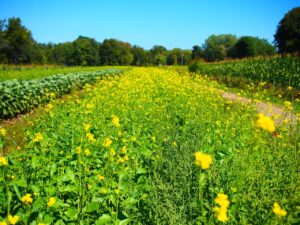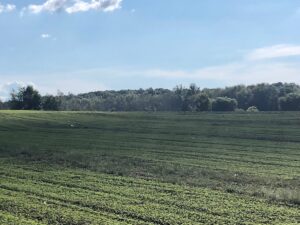Final report for LNE14-335
Project Information
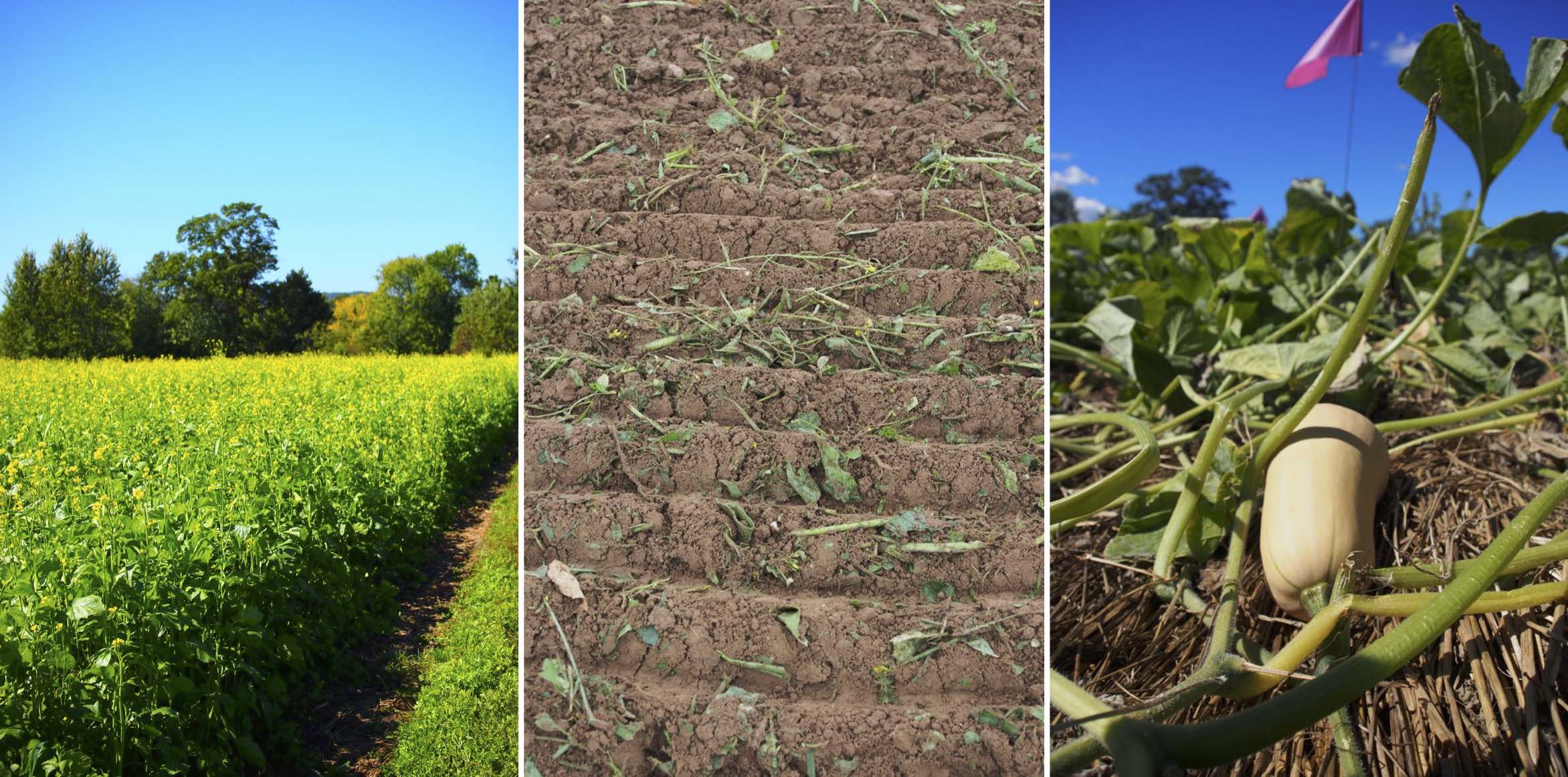
From left: ‘Caliente 199’ mustard cover crop; chopped, incorporated, cover crop for packed into
surface soils for biofumigation; healthy butternut squash atop rolled rye mulch in reduced tillage
treatment, Hudson Valley, 2015 & 2016.
Phytophthora blight (PB) is a potentially devastating soil-borne crop disease and top concern for vegetable growers in the Northeast and the northeastern Midwest where susceptible cucurbit and nightshade crops contribute to major portions of farm incomes and to the greater vegetable industry. Soil health improvement has been proposed as a fundamental component of an integrated PB and general soil-borne disease management programs. Certain brassica cover crops are capable of providing unique biofumigation services to soils with high soil-borne pathogen loads, and reduced tillage (RT) can allow soils to regenerate functions that further mitigate soil-borne diseases. This project was aimed at increasing grower awareness and adoption of integrated PB management and soil health improvement through demonstration and research trials evaluating 1) biofumigation with brassica cover crops and 2) reduced tillage (RT) with rolled cereal cover crops as integrated components of PB management. These components were evaluated through a series of on-farm trials New York State conducted in tandem with a plot-scale trial at Cornell’s Long Island Horticultural Research and Extension Center (LIHREC) over two years.
In 2015, seven collaborating growers completed a total of 13 on-farm trials with brassica cover crops grown for biofumigation. In 2016, four remaining grower-collaborators (from trial year 2015) followed their biofumigation trial with RT treatments as a two-step soil health program designed to simultaneously mitigate PB. All four remaining grower-collaborators successfully completed a RT vs. “grower standard” control comparison with a cucurbit response crop across nine total replications. Corresponding treatments were trialed at LIHREC. Cucurbit cash crop yield response and cover crop biomass C and N was measured each year. A soil health assay was conducted after year 2, along with measurements of soil infiltration rates.
In all trial years and locations, blight from P. capsici was absent or very low, limiting opportunity to collect evidence of biofumigation and RT treatments on disease suppression. Cucurbit yield and soil health parameters were largely unaffected by treatments (p > 0.10). Cover crop biomass N and C returned to soils after biofumigation + RT treatments was ~3.5-5x greater than control treatments using standard overwinter rye cover crops (Oct.-April), indicating high potential for soil conservation and health improvement over time. These returns to soils may be especially noteworthy due to a positive association found between soil infiltration rates and soil organic matter levels (r2=0.87, p < 0.01) the soil health data. Rye cover crop biomass may also be important in the RT component, as PB was only found in plots where rye biomass was < 7000 lb/ac.
At least 1090 growers, researchers, and educators were directly delivered project information through workshops/field days, presentations, and one-on-one consultations/mentoring. These occurred in local and regional events in NY, NJ, IN, WA, and at an international conferences in MD and CA. A total of 15 growers in NY were verified to have adopted either biofumigation, reduced tillage, or both practices for PB management throughout the project. Six of those growers responded to post-project surveys and indicated that on average they integrated 12 different approaches to manage PB, and they were more likely than not to continue integrating either biofumigation and/or RT alone again (~65% chance) or both practices again (~70% chance), and would accordingly recommend to other growers. These growers also reported a total of five other peer growers that expressed intent to adopt biofumigation and/or RT for managing PB. On average, these growers ultimately indicated that this project led to a 70% increase in knowledge about how to use biofumigation and RT practice to effectively to help mitigate PB in an integrated management program.
Forty vegetable growers across three regions of NY will integrate multiple soil-borne disease management practices that may include biofumigation with brassica cover crops and reduced tillage on at least an 5 acres per farm, recovering $1000 - $4000 per acre otherwise spent and/or lost on diseases like Phytophthora blight.
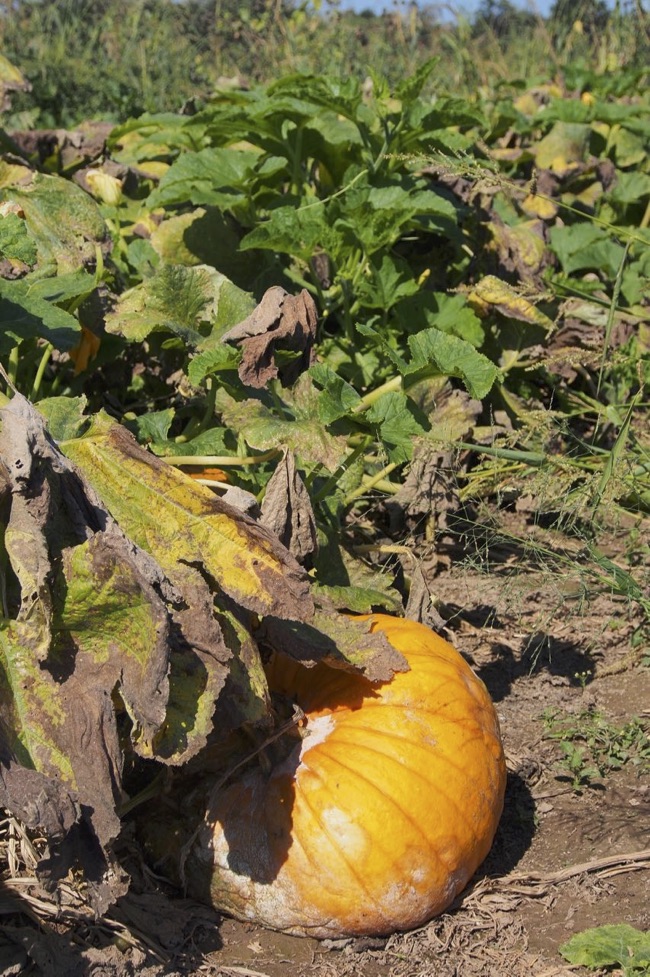
The soil-borne pathogen Phytophthora capsici, which causes Phytophthora blight (PB), increasingly threatens economically important vegetable crops in the northeastern US annually constituting 33-40% of all vegetable crops grown (~300,000 acres). Phytophthora capsici persists in soils for many years without a crop host present. Infested fields on average lose ~30% of susceptible crops and ~80-100% in wet years, even with fungicides. Contained incidents become widespread after flooding events, and more frequent instances of heavy rainfall are a proven emerging component of the northeastern climate. Phytophthora capsici is established in 25 NY counties, and epidemics have been likewise reported by Extension in five other northeastern states. Four grower-informed groups in the northeast list PB management as a top research priority. Soil biofumigation with brassica cover crops and reduced tillage are promising components of integrated soil-borne disease management programs that will remain underutilized without better quantification of effects and participatory research with growers.
Cooperators
Research
We hypothesized that 1) biofumigation will reduce soil-borne pathogen inoculum viability in soils, and that 2) reduced tillage and cover crops will further reduce opportunities for pathogen inoculum spread and viability, leading to reduced crop disease and increased yields. Using PB as a proximal indicator of effects of these practices on soil-borne diseases, we also expect additional increases in soil infiltration rates, nitrogen and carbon returned to soils in cover crops, and general soil health.
Our on-farm research was conducted in three regions of NY representing a spectrum of agroecosystems and soils found in northeastern vegetable production regions, and at Cornell’s Long Island Horticultural Research and Education Center (LIHREC). The LIHREC has a long history of PB research. Our field research objectives were to 1) establish a two-year, field-scale, on-farm trial (six trials were targeted) and 2) a corresponding plot-scale trial at Cornell’s LIHREC to assess effects of biofumigation with brassica cover crops, reduced tillage, and these factors integrated as a soil health program that guards against soil-borne disease proliferation. Phytophthora blight was used as a proxy in this study for measuring any treatment effects on soil borne disease suppression. In anticipation of pre-identified barriers related to investments into new cultural practices (learning curve, equipment, etc.), we also collected data on indicators of soil health and conservation benefits from these treatments including 1) organic carbon returned to soils and nitrogen recycled to soils in cover crops, and 2) soil infiltration rate changes, to importantly document a wider spectrum of benefits/incentives incurring from adopting these multifunctional practices.

On-farm experimental design:
Growers with widespread natural infestations of the soil-borne pathogen Phytophthora capcici established on-farm “grower-standard practice” control plots adjacent to plots where Brassica cover crops were used for biofumigation in year 1, and reduced tillage (RT) into rolled rye (Secale cereale) cover crops was used in year 2 before cucurbit cash crops. In year 1, seven collaborating growers planted cucurbit crops after brassica cover crops incorporated for biofumigation, vs. their grower standard control treatments. In year 2, four collaborating growers continued their trials with cucurbits cash crops planted into reduced tillage treatments that had been biofumigated in year 1, vs. their grower-standard controls. Growers chose which PB susceptible crop to plant (both pumpkin and winter squash were used), brassica cover crop species/variety and timing of biofumigation (winter, fall, or spring) their standard control treatment, and elected any additional treatments of interest or added replications.
Our on-farm experimental design used farm as the replicate/block where each farm implemented a minimum of one field-scale replication of each treatment (with 4-6 subsamples); two collaborating growers elected to add more replications and/or treatments within their sites. Data from certain sites that had problems with management that were expected to confound results were not included in analyses; data from all sites in western NY, and one from Long Island were ultimately excluded from final analyses for this reason. Grower standard controls also varied, but were controlled sufficiently to maintain a biofumigation vs non-biofumigated treatment contrast that consistently included RT in year 2.
Long Island Horticultural Research and Extension Center experimental design:
Our plot-scale trials at LIHREC used a standard over-winter rye cover crop (Oct planting, April incorporation) in a conventional tillage-based system as a baseline grower standard control, and contained treatments corresponding to those used on-farm trials. Treatments at LIHREC also included a 1) winter brassica cover crop species (‘Nemat arugula) and a 2) treatment that used reduced tillage both years and included living mulch (white clover), but both were eliminated from the final analysis due to complications with management. Split-plot treatments with applications of beneficial organisms (biocontrols/biofungicides) were also included in the original experimental design, but this component was abandoned due to logistical constraints. At LIHREC a randomized complete block design with four replications of each treatment was used.
Methods:
Plantings of winter brassica (‘Nemat’ arugula) cover crops began mid-September 2014, spring brassica cover crops (‘Caliente 199’ mustard) were planted between mid-April and early-May 2015, and fall sown brassicas (‘Caliente 199’ mustard) were planted in early-August 2015. Successful brassica cover crops were given adequate fertility containing 50-100 lbs of available N, terminated 2-4 weeks after flowering stage (after ~50-60d of growth) with fail or rotary mowing, incorporation, rolling/culti-packing, and irrigated if needed for biofumigation.
Cucurbit cash crops that followed spring biofumigation were planted at sites in early summer 2015 within 1-2 weeks after biofumigation. Fall biofumigation treatments were followed by winter rye. All rye cover crops used in standard grower practices or before reduced tillage were planted between late-September to early-October. Rye crops were either terminated in early mid-April in tillage-based treatments, or grown to anthesis stage and rolled flat to form a dead mulch in Mid-may before zone-tilling for cucurbit plantings in early summer 2016. To assess potential treatment effects of interest, we measured cucurbit cash crop yields, estimated crop losses from PB, and cover crop carbon and nitrogen content in both years 1 and 2, and measured soil infiltration rates and conducted a Cornell soil health assessment in year 2.
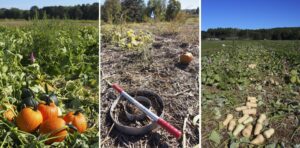
Statistical analysis:
Our on-farm data analysis focused on biofumigated + reduced-till vs. grower standard control treatment effects on cucurbit cash crop yield using a mixed model analysis (treatments as fixed effects, and farm/block/replicate as random effects). Treatment effects were considered significant when p ≤ 0.10. Qualitative records of grower experiences in implementing these novel practices were also collected to gain insight into new perspectives on management and potential barriers to adoption. These include prepared post-project evaluations sent to growers in NY, and post-program evaluations from two educational events in 2019.
Of the original seven collaborating growers that trialed a mustard cover crop for biofumigation in year one (2015), four of those growers successfully completed the full 2-year biofumigation + RT program vs. “grower standard” control comparison in 2016. Data from these four sites were used in final analyses. All used a cucurbit response crop, across nine total replications. Weather was not conducive to a proliferation of PB at any trial sites in either year, or at any site (generally dry during the cucurbit growing season). Our ability to collect evidence of treatment effects related to PB was therefore negligible.
Cucurbit yield, Phytophthora suppression:
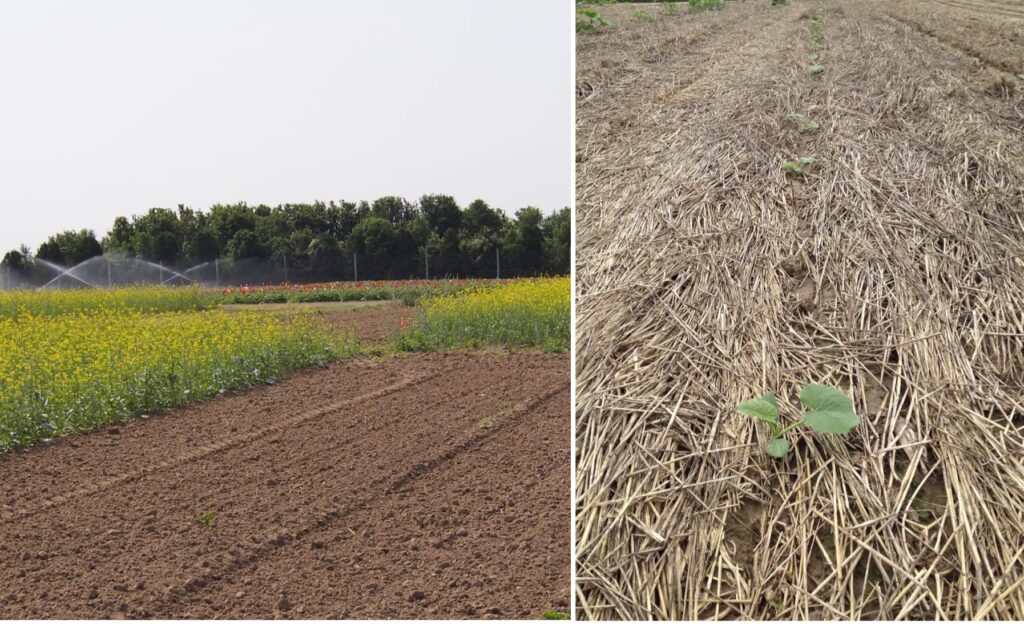
Of all the on-farm replicates included in the final analyses of the study over both years, PB was only found in two control treatment subsamples, and one biofumigation + RT subsample within two different replicates. Estimated lbs. of cucurbit yield lost to PB in these subplots were subtracted from the total yield of the subplot (as unmarketable fruit). In the absence of prominent disease effects, there was insufficient evidence to substantiate any significant effect of brassica cover crops/biofumigation in 2015 (p = 0.58) or biofumigation + RT in 2016 (p = 0.30) on yields of marketable cucurbit crops. (See figure 4 in: Biofumigation-RT-ASA-Baltimore-poster-Edit-1)
At LIHREC, treatments which corresponded most closely to those used within the on-farm trials were analyzed for final results (see methods section above for treatments eliminated from final analysis). In 2015, cucurbit yield response to brassica cover crops/biofumigation treatments in 2015 treatments were not evident in 2015 (p = 0.35), but in 2016, there was marginal evidence of differences between treatments (p = 0.10). Response in 2016 was not related to tillage or biofumigation exclusively though. The highest yielding treatment had biofumigation with spring-planted mustards in 2015 followed by conventionally-tilled overwinter rye cover crops in 2016. The lowest yielding treatments were the standard control with conventionally-tilled overwinter rye cover crops in both years, and a treatment that had biofumigation with spring-planted mustard in 2015 followed by reduced-till rolled rye cover crops in 2016. A fourth treatment using biofumigation with fall-planted mustard in 2015 followed by reduced-till rolled rye cover crops in 2016 did not significantly differ from either the lowest-yielding or highest-yielding treatments. Treatment differences are hypothesized to be dynamic and related to differences in weed control, which was reduced in RT treatments, along with possible delayed fertility release from cover crop biomass in RT treatments, and possible soil compaction from excessive tractor traffic in trying to maneuver equipment within small plots in RT treatments.
Cover crop biomass C and N returned to soils, conservation potential:
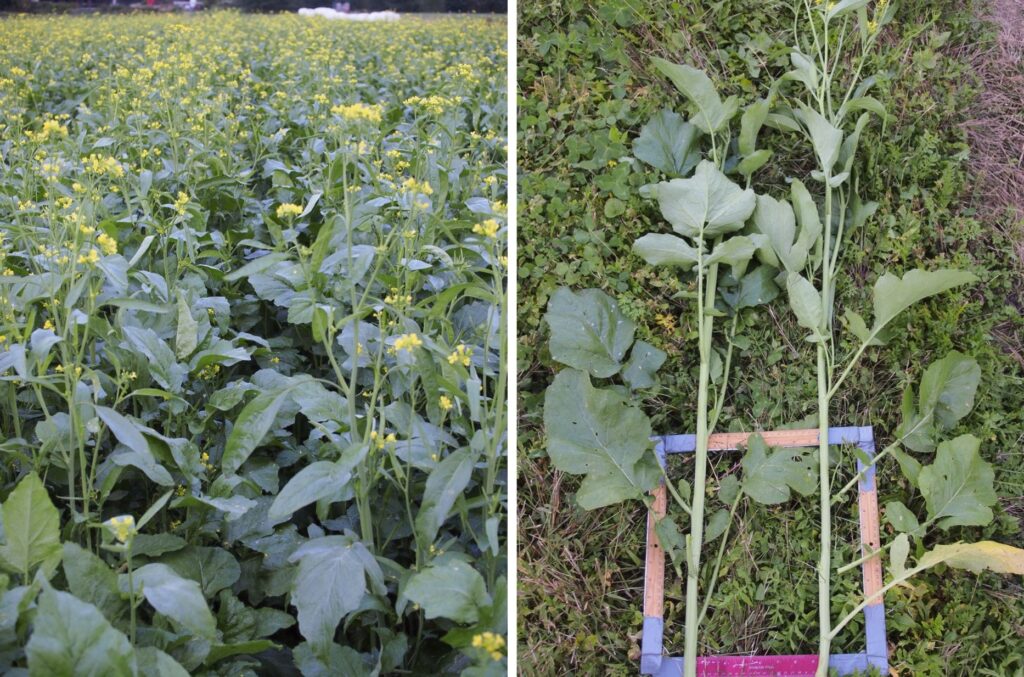
On-farm mustard cover crops that escaped considerable drought and were managed reasonably well with recommended planting timings, fertility, and 50-60 days of growth returned 1483-2017 lbs/ac of C and 125-164 lbs/ac N to soils in biomass (3993-5391 lbs/ac total). Measurements at LIHREC were similar for late summer-planted mustard plantings which returned 1769 lbs/ac C and 174 lbs/ac N to soils in biomass (4347 lbs/ac total). Drought was severe during the spring-planted mustard plantings at LIHREC and brassica cover crop biomass returns to soils were ~3x less than the fall plantings (despite prudent management otherwise). ‘Nemat’ arugula cover crops planted in early September 2014 were deemed a non-viable overwintering variety choice for biofumigation in NY due to complete winterkill, but measurements from well-managed cover crops in farm and at LIHREC cover crops illustrated that ~639-671 lbs/ac of C and 59-80 lbs/ac of N were returned to soils after winterkill (1859-2174 lbs/ac total).
Standard overwinter rye cover crops, typically planted in October and terminated in April, returned 494 lbs/ac of C and 34 lbs/ac N to soils in biomass as averaged across on-farm sites and at LIHREC (1174 lbs/ac total). In RT treatments, rye cover crops grown for a rolled mulch are grown to a later stage (anthesis) and typically terminated in mid to late-May; at on-farm sites and at LIHREC these cover crops, on average, returned 3083 lbs/ac of C and 110 lbs/ac of N to soils in biomass (7030 lbs/ac total). Finally, when mustard cover crops were managed reasonably well (and free from severe drought) they returned 1725 lbs/ac of C and 130 lbs ac N on average to soils in biomass (4366 lbs/ac total) at on-farm sites and at LIHREC. Using these estimates, over a two-year management scenario, growers who replace a standard overwinter rye cover crop with a brassica cover crop grown for biofumigation and rye cover crops grown for a rolled rye mulch could increase their C returns to soils by ~5x and N returns to soils by ~3.5x. (See figure 5 in: Biofumigation-RT-ASA-Baltimore-poster-Edit-1)
Soil health parameters and soil infiltration rates:
Similar to yield response, there were few significant effects of brassica cover crops and RT treatment on measured soil health parameters. At on-farm sites, no soil health parameters were significantly affected by treatments (all p > 0.10). Unrelated to treatments, soil infiltration rates were associated in a positive, non-linear relationship with inherent soil organic matter (SOM) levels (transformed log fit, r2 = 0.87, p < 0.01), and conversely were negatively associated with % sand content in soils (transformed log fit, r2 = 0.83, p < 0.01). Soil organic matter content was also likewise negatively associated with % sand content (transformed log fit, r2 = 0.88, p < 0.01) and positively associated with % silt content (transformed log fit, r2 = 0.90, p < 0.01). Infiltration rate responses to each were relatively linear until sand content was < ~30%, silt was > ~70%, and soil organic matter content was > ~3%, after which, infiltration rates began responding in an increasing, non-linear, exponential fashion. (See figure 6 in: Biofumigation-RT-ASA-Baltimore-poster-Edit-1)
At LIHREC, amongst treatments used in the yield analysis, treatments with RT had significantly lower soil infiltration rates (p = 0.02) and available water holding capacity ratings (p = 0.04) than conventionally tilled treatments. Soil respiration ratings were also greater in RT treatments when all treatments were included in the analysis (p < 0.01), but not when analyzed only amongst the treatments included in the yield analysis (p = 0.38). There was no apparent association between infiltration rates and SOM at LIHREC, but similar to the on farm data, soil organic matter content was also likewise negatively associated with % sand content (r2 = 0.70, p < 0.01) and positively associated with % silt content (transformed log fit, r2 = 0.65, p < 0.01). With regard to the aforementioned nonlinear increases in infiltration rates associated with measured soil properties at the on-farm sites, soils at LIHREC all contained > 30% sand , < 60% silt and organic matter levels < 2.7%. The poor response of soil infiltration rates and water holding capacity to RT treatments is hypothesized to be a dynamic result of poor aggregation in sandy soils leading to compaction in the first year of transitioning form conventional tillage to RT, later season cultivation for weed control in conventional till plots, and incorporation of rye cover crop biomass residues into soils in spring in conventionally tilled plots, vs RT, which did not have biomass incorporated in 2016.
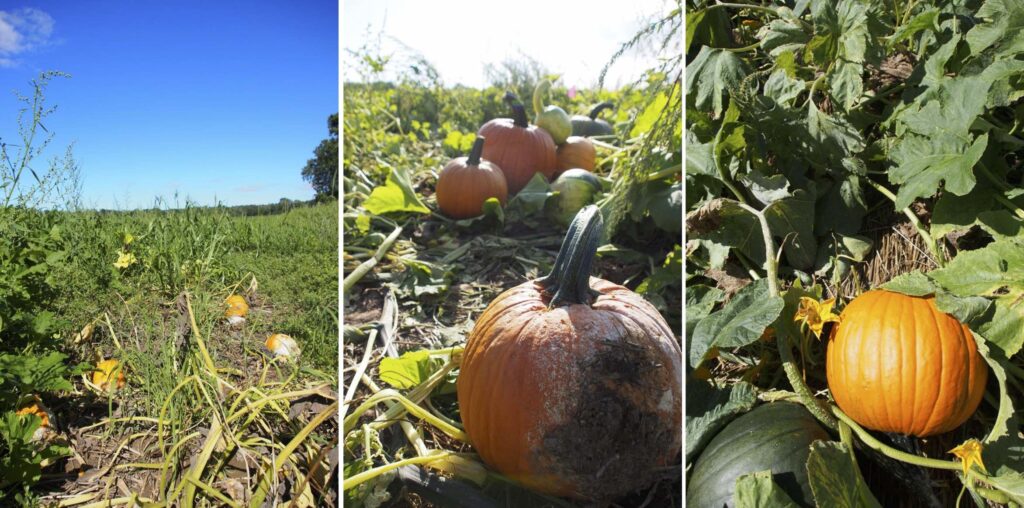
This study was unable to detect conclusive evidence that brassica cover crops and biofumigation, or biofumigation + RT effectively 1) suppressed PB in cucurbit cash crops, or 2) otherwise increased, or decreased their yields compared to grower standard practices in the absence of disease. This study also was unable to largely detect effects on soil health from treatments, with few exceptions. Despite some promising results in the LIHREC trials regarding treatments with brassica cover crops and biofumigation, and negative results in treatments with RT, implications were not straightforward and conclusive with regard to best management and scope of inference beyond LIHREC and the Long Island region of NY. Data from RT subplots where PB was found and anecdotal observations from plots with RT in this study suggest that biomass of rolled rye may need to be > 7000 kg/ha in order to form a robust mulch that prevents cucurbit fruit from contacting soils (and to effectively suppress weeds). Longer-term studies in more than one region are likely needed to 1) increase opportunities to collect evidence of treatments on PB suppression (studies which occur in years with weather that incites substantial PB pressure), and to 2) allow opportunity for potential cumulative effects of biofumigation and/or RT practices (more than one cycle of each practice, in rotation) to present themselves and affect soil health parameters. An inadvertent, but important, finding of this study was that short-term benefits of these practices may not reliably occur. It is important that growers understand this, and that multiple benefits of these practices could still precipitate in the longer-term.
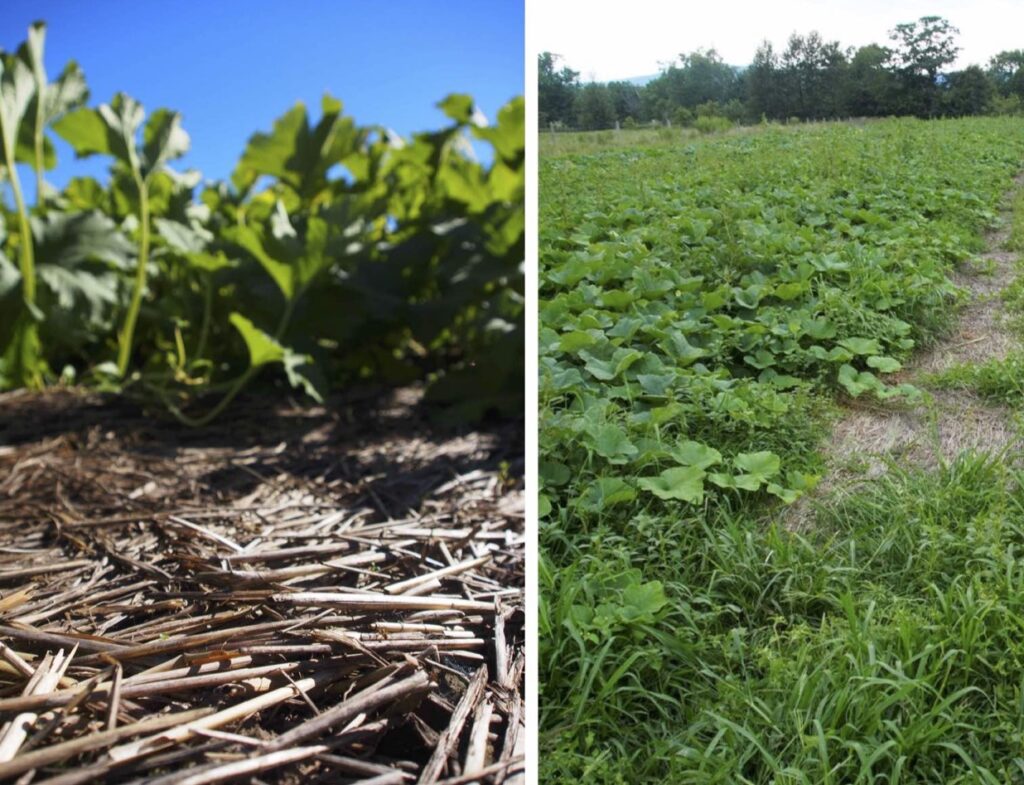
This study illustrated that a program using brassica cover crops for biofumigation and reduced tillage with rolled rye cover crops presents an opportunity for substantially increasing C and N returns to soils compared to standard overwinter rye cover crops. If growers can learn to efficiently integrate these practices within a ≥ 2-year soil health management program, the ~5x greater C returns and ~3.5x greater N returns to soils observed in this study are likely to precipitate cumulative effects on soil health and conservation. Increased returns of soil C are likely to build SOM over time, and increased N returns illustrate potential for cover crops to increase nutrient cycling services and improve inherent fertility over time. The brassica cover crops in this study all proved to be highly effective catch crops for available soil N, commonly returning ~30-130 lbs/ac more N to soils in biomass than was added to grow the cover crop. Brassica residues also were relatively labile when terminated (average C:N ratio = 14, N content 2.7%), so the likelihood for rapid recycling of nutrients from residues to subsequent crops is high.
Education
Our educational program utilized three central approaches to disseminate project-related information: 1) direct grower engagement through participatory research, 2) in-person educational and networking grower events, and 3) access to static educational resources (print, online, and audio-visual educational materials).
Our educational curriculum included:
1. Understanding the Phytophthora capsici pathogen, its spread, and the causes and development of PB in agriculture.
2. Understanding biofumigation mechanisms, selecting appropriate biofumigation species/varieties, fertilization, cover crop termination timing, and biofumigation steps.
3. Reduced tillage approaches for PB/soil-borne disease management (ex: planting into zone-tilled rolled, mowed, or sprayed-out cover crops, or living mulches).
4. Integrating components of PB/soil-borne disease management, including biofumigation, reduced tillage, fungicides, biocontrol organisms, sanitation, in-field water management, and cultivar resistance.
5. Understanding additional benefits of soil health improvement from cover crops and reduced tillage (ex: improved nutrient cycling efficiency, soil organic matter maintenance, soil drainage/infiltration etc.).
6. Addressing potential observed barriers to adoption of novel PB management practices.
Potential regional grower peer mentors were be recruited through county Extension and involved through our participatory on-farm research component. Extension guided grower collaborators through the on-farm research process, the steps of successfully biofumigating with a brassica cover crop, and using reduced tillage for combating soil-borne disease. Grower collaborators were targeted to serve as peer mentors facilitating adoption diffusion in each region, and Extension was likewise available to help guide other growers adopting these practices as a result of the project. Other beneficiaries interested in adopting practices being employed in this project were be provided with on-demand individualized guidance and educational materials from Extension, and directed to an area peer mentor for support and perspective on successful adoption approaches.
Through Extension, grower, and researcher networks, growers and other stakeholders were recruited to participate in the project's educational events to explore on-demand web resources. We targeted demonstrations of novel PB management practices at field days, and results presented at statewide/regional winter workshops and conferences, a webinar, and in Extension publications and websites. A record of producer experiences, and an integrated PB management and biofumigation “how-to” reference sheet and video was targeted to be made available on Cornell Extension websites. We also targeted opportunities to disseminate our findings to growers, Extension, and researchers outside of NY at regional and national educational venues.
Milestones
1) Six growers battling Phytophthora blight (PB) in three distinct regions of NY are recruited by Extension and guided through the process of choosing treatments and establishing a trial including a brassica cover crop for biofumigation and reduced tillage. Beneficiaries gain first hand experience with novel, integrated management tools for PB management. Beneficiaries learn the logistics of selecting and growing brassica cover crops for biofumigation, the biofumigation process, methods of reduced tillage that mitigate PB and soil borne disease, and enhanced understandings of soil health management.
6
7
Completed
October 01, 2016
This milestone was completed for the two 2014-15, and 2015-16 trial years. Seven (of a targeted six) growers trialed brassica cover crops for biofumigation vs. their standard practice, but three grower collaborators from 2014-15 chose not to continue the trials into 2016. Four (of a targeted six) collaborating growers continued participate for the reduced tillage (RT) portion of the trials in the Long Island and Hudson Valley regions. To offset the loss of data from lost grower collaborator trial sites, the remaining collaborators were encouraged to implement more than one replication at their site in 2016; at two Hudson Valley sites, one grower established two replications (of which, one was compromised), another grower established three replications, while another was able to establish four.
2) 75 growers attend field days (25/region) and learn about PB and integrated approaches to managing PB and soil-borne diseases through viewing trials and from the project’s grower collaborators and research team.
75
112
June 30, 2015
Completed
June 30, 2015
The project team added at least 60 grower contacts to this portion milestone through three regional grower twilight meetings in summer 2015; ~52 growers were previously introduced to the project in summer meetings before the 2015 project year.
3) 300 growers total attending winter conference/meeting presentations will learn about integrated approaches to managing PB and soil-borne diseases and year 1 trial results.
300
318
March 31, 2016
Completed
March 31, 2016
Presentations during winter of 2016 disseminated information on biofumigation practices and preliminary trial results, reaching at least ~285 growers (and other stakeholders). The presentations were given in a statewide grower conference in Central NY, at a regional grower meeting and a statewide conference in NY's Capital District region, and at another grower meeting in NY's Hudson Valley region in 2016. A link to the one of the project-related presentations given in 2016 is provided below, at end of this section. Approximately 33 stakeholders were connected to the project via winter meetings before the 2016 project year.
4) 75 growers attend field days (25/region) and learn about PB and integrated approaches to managing PB and soil-borne diseases through viewing trials and from the project’s grower collaborators and research team.
75
93
June 30, 2016
Completed
August 31, 2018
Due to 1) project demonstration and dissemination events in summer 2015, 2) a considerable project information dissemination effort at 2016 winter meetings, and 3) a lack of new information from the project to share, the research team refrained from holding dedicated project-related summer demonstration events in 2016. We also alternatively decided to bring in out-of-state guest speakers to talk about the components related to the project (see Milestone 5). The project efforts were nonetheless shared once in summer 2016 at a general IPM grower event in the Hudson Valley, and at two other general IPM grower events in western NY, reaching an additional ~70 stakeholders total. The western NY region would have benefited from a demonstrative event in 2016, but their demonstration sites were lost. To help compensate for these lost trial/demonstration sites, we alternatively held an extra winter meeting in 2017 to share project-related information (see Milestone 5) and final project results. The 2017 project year was disrupted by the project PI relocating to Washington State, but in 2018, gave an invited talk on the project results to an additional 15 stakeholders at a field day in the western part of the state. A demonstration field event was also held in WA in summer 2018 on biofumigation (partially leveraged by this project), and presented project information to another 8 stakeholders.
5) 300 growers total attending winter conference/meeting presentations will learn about integrated approaches to managing PB and soil-borne diseases and project results. January-March 2017.
300
310
March 31, 2017
Completed
January 31, 2019
Three different events with presentations on subjects related to the project were completed in winter 2017: 1) Farmer and biofumigation expert Dale Gies of High Performance Seed in eastern Washington was a featured speaker at an annual statewide grower event in Central NY, 2) a presentation was given by the reserch team at a regional grower event in Long Island, and 3) a grower event in Western NY featured Extension faculty expert Dr. Mary Hausbeck from Michigan State University in a focused session about integrated Phytophthora blight management. These presentations connected another ~170 stakeholders to the project.
Approximately 140 more farmers participated in winter workshops and program talks in 2018 and 2019 where project information was shared.
- Version of presentations given at winter meetings in NY, 2015-2016
- Short guide to biofumigation success given out at meetings
- Presentation given at NJ Agricultural Convention and Trade Show, 2017
- Presentation given in Indiana Horticulture Congress, 2018
- Presentation given at Tilth Alliance Conference in WA, 2018
6) 1500 beneficiaries total nationally will learn about our biofumigation with brassica cover crops and integrated approaches to managing PB and soil-borne diseases via the above contacts, and Extension materials posted online, a webinar, and an instructional video.
1500
205
August 31, 2017
In Progress
A webpage with of project-related information was created in 2016 as an on-demand resource for increase exposure to the project and its components, and general Phytophthora blight management resources: http://ulster.cce.cornell.edu/integrated-phytophthora-management-biofumigation-reduced-tillage. Project-related information and a link to the above website was also integrated into Cornell's main vegetable pathology web site, Veg MD http://vegetablemdonline.ppath.cornell.edu/NewsArticles/PhytoBlight_cucurbits-others.html., which is additionally accessible from to LIHREC's http://blogs.cornell.edu/livegpath/gallery/cucurbits/phytophthora-blight-in-cucurbit-crops/. These web presences provide ongoing, widespread exposure to project information.
Completion of this milestone was compromised due to 1) logistical constraints following the PI's relocation to WA in 2017, and 2) website visit statistics not being available to the project team. In addition to the PI losing access to Cornell Cooperative Extension's website content and access to Cornell's webinar resources, the proposed instructional video was also not able to be completed.
The project was alternatively exposed to broader nationwide audiences and added impact by by getting information out to researchers and educators in regions outside of NY. Project information was presented to ~30 researchers ad educators at a meeting in Canada in 2015, ~55 researchers ad educators at statewide multi-state regional events in IN, NJ and WA in 2018-19, and to ~120 researchers ad educators at two international conferences in MD and CA in 2019. A simple writeup of the project, entitled "Understanding brassica cover crops, biofumigation, and the connection to soil health" will also be featured in March on the Soil Science Society of America's "Soils Matter!" blog for popular audiences, which regularly reaches 30,000 readers per month. A webinar presenting final project results is currently scheduled for Mid-March 2019.
- Talk given at ASA/CSSA and SSSA International meetings 11/2018 and 1/2019
- ASA/CSSA Baltimore presentation recording: https://scisoc.confex.com/scisoc/2018am/meetingapp.cgi/Paper/113143
- SSSA San Diego Presentation recording: https://scisoc.confex.com/scisoc/2019sssa/meetingapp.cgi/Paper/115735
- Poster presented at ASA/CSSA and SSSA International meetings 11/2018 and 1/2019
- Link to SSSA's Soils Matter! blog where a simple writeup about the project will be posted in March 2019: https://soilsmatter.wordpress.com/
7) 40 growers in three distinct regions of NY (10-15/region) are mentored by our grower collaborators and/or Extension in implementing integrated approaches to PB and/or soil-borne disease management in each respective region represented in the project.
40
62
September 01, 2017
In Progress
In addition to our 7 grower collaborators, 4 other Hudson Valley region growers trialed brassica cover crops for biofumigation in fall 2014 and/or in late summer 2015 under the guidance of Extension, and at least 4 other growers trialed cover crops for biofumigation between 2015-2018. At least 62 total growers were directly guided by Extension between 2014-2018 regarding adoption considerations and best management practices of using reduced tillage and brassica cover crops for biofumigation.
Milestone activities and participation summary
Educational activities:
Participation summary:
Learning Outcomes
Post-project surveys were distributed by email to all 15 growers that directly participated in the project research and those that were otherwise verified to have adopted either biofumigation or RT or both throughout the project's duration (2014-2018). Six growers responded. An electronic post-project survey (https://wsu.co1.qualtrics.com/jfe/form/SV_bEPJIHBRckmZ5dj) was also sent to six Cornell Cooperative Extension educators for statewide distribution to grower networks, but response was negligible. One Extension Educator responded to the electronic survey. A post-program survey was additionally used to evaluate changes in grower awareness/knowledge about biofumigation following a field event on held in WA in 2018. The project team will attempt to survey growers again to help verify changes in knowledge, attitudes, skills and/or awareness following a webinar scheduled for March 2019.
Of the six growers that responded to the post-project survey, responses were highly variable but all indicated that they were, on average, 1) ~65% likely to use either biofumigation or RT again alone, 2) 70% likely to integrate both again for managing PB and soil health, and 3) that the project was 70% effective in helping them understand how to use these practices effectively for integrated PB management. One grower indicated that they were unlikely to use RT again, and another indicated that had not used RT, and were unlikely to in the future. These growers reported using an average of 12 different management components for mitigating PB, and that for 5 of the growers, PB was thier top soil-borne disease issue, causing between $100-1250 per acre/yr in crop losses. Despite our lack of evidence indicating cash crop yield improvement from these practices, three growers indicated that they perceived biofumigation and/or RT practices were nonetheless beneficial in the short-term, and four indicated that they expected them to be increasingly beneficial as a long-term investment. Benefits that growers mentioned perceiving since the project's start were 1) possible decline in PB from both practices (variable, some unsure), 2) soil health improvement with added cover crops + RT, 3) added weed control options resulting from biofumigation and rolled rye mulches, and 4) reduced fuel costs from using RT. All growers also expressed some reservations about the cost/benefit of both practices though (and integrated practices in general); among those indicated listed were: 1) the precise timing needed for using biofumigation and RT effectively 2) the learning curve of adoption and time demands of using these practices 3) the cost of growing a brassica cover crop for biofumigation and the cost of RT equipment, 4) the the variability of PB infection (no clear benefit in low PB years), and 5) weed control concerns in RT. Most growers indicated that they compromised on at least one best management practice for effective biofumigation due to time, resource constraints, or lack of understanding of the importance of a given component. Our trial data and anecdotal observations of rolled rye mulches in the trial also suggested that weed control was more likely to be effective when rye biomass was >7000 lbs/ac. Only three growers attempted to estimate the gross crop value that these practices helped them recover/gain, which ranged from break-even to $10,000 in crop-value gained per acre.
Growers indicated that thier likeliness to recommend biofumigation and/or RT to other growers corresponded with thier own likeliness to use the practices again (aforementioned above), and that a total of five of thier peer growers had expressed intent to adopt one or both practices. In addition to the project team, one other Extension educator was verified by the post-project survey to have begun educating growers about using biofumigation and RT for managing PB. Another five Extension Educators and a private consultant in the northeast also verbally verified that they intended to use this' project's information with their constituent growers. Eleven other growers from two event on held in WA in 2018 also verified an intent to use brassica cover crops for biofumigation, another eight indicated that they were considering it, and all eight participants indicated an ≥ 80% increase in knowledge about the topic. All verified changes in knowledge, attitudes, skills and/or awareness were reported here were verified to to be a direct result of this project.
Performance Target Outcomes
Target #1
40
Integrating multiple soil-borne disease management practices that may include biofumigation with brassica cover crops and reduced tillage.
15
Farmers that integrated biofumigation with brassica cover crops and/or reduced tillage for management of Phytopthora blight or other soil borne diseases and soil health management.
0.1 to 25+ acres per farm.
Claims of reduced Phytophthora blight, and resulting recovered and/or improved yields from biofumigation with brassica cover crops and RT.
By 2018 at least 15 growers had integrated brassica/biofumigation and/or reduced tillage for soil borne disease management as a result of the project. Verification was exceedingly difficult after the PI's relocation to WA in 2017, and specific issues barriers to verification are aforementioned in Milestones 6 and 7, and in the Learning Outcomes section. Verified barriers to adoption, and indicators of the are also detailed in the Learning Outcomes section. We anticipate an increases in verified project impact towards our performance target after surveying growers following a webinar scheduled for March 2019.
Growers may also participate at any point in an online survey related to this project and the trialed practices at:
https://wsu.co1.qualtrics.com/jfe/form/SV_bEPJIHBRckmZ5dj
Additional Project Outcomes
Growers that have been involved in this project thus far under the guidance of Extension (either formally or informally) have generally expressed and/or exhibited notable gains in understanding how to manage brassica cover crops, the biofumigation process, reduced tillage, and Phytophthora blight and soil health management in general. For the research team also, the process of working with growers on-farm has highlighted what the barriers to successful adoption of brassica cover crops and biofumigation may be for growers across the state and greater Northeast region, and what components may improve research and educational efforts.
Multiple factors have been elucidated through the project regarding adoption and viability of integrated soil borne disease management, biofumigation and reduced tillage, including:
- Growers that had grown brassica cover crops before perceived general positive effects on subsequent cash crop yields and were further interested in quantifying the impact of their use in mitigating PB. Favor for the reduced tillage aspect was present for some growers, but less ubiquitous.
- In Western NY, the core of the interest was in using brassica cover crops, but growers in this region expressed crop rotation concerns (disease risk concerns) because brassica cash crops are common in this region. Western NY growers were also more unsure of the reduced tillage aspect; reduced tillage in this region is less widely adopted than in Long Island and the Hudson Valley, and growers were unfamiliar with the practice and lacked equipment. The western NY region was the most difficult region to recruit collaborating growers and adoption for these reasons.
- Each arugula crop suffered complete winterkill even with timely fall seeding (early-mid September); four other Hudson Valley growers informally trialing ‘Nemat’ arugula in 2014 also experienced complete winterkill.
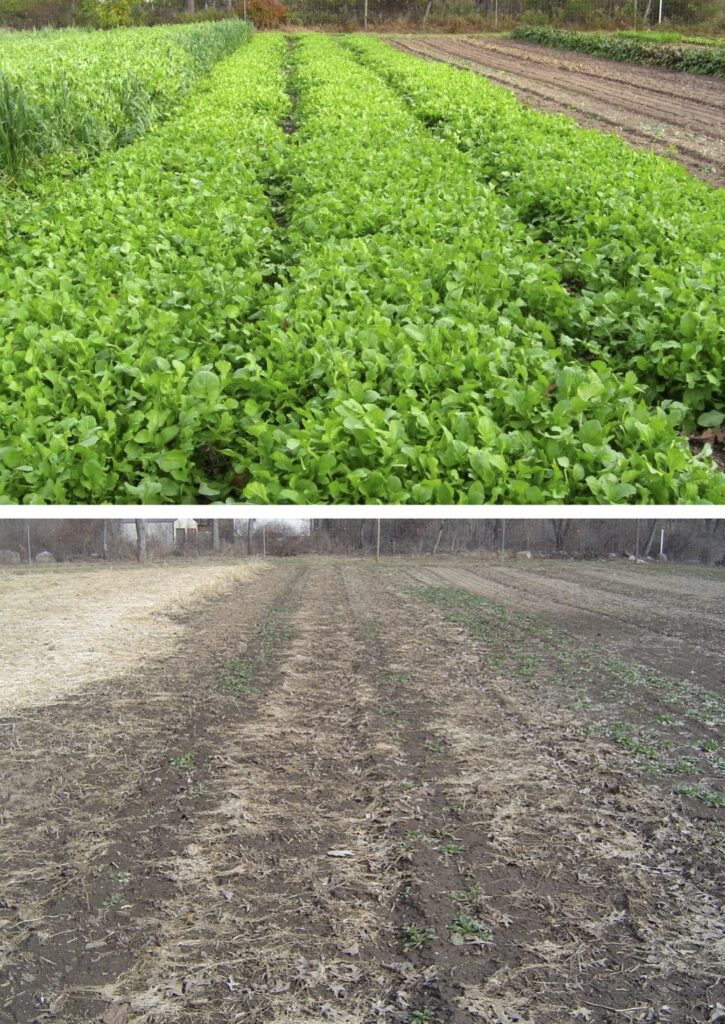
'Nemat' arugula at informal trial site in NY in Fall 2014 (upper) and Spring 2015 (lower). Because winter mortality of this variety was 100% at all sites where it was trialed, it is not a viable winter variety for biofumigation in NY, but may still be an effective catch crop for soil N between late summer and midwinter if growers are looking for a cover crop that winter-kills. - In 2015 Growers experienced variable degrees of success completing the biofumigation process with fall-sown winter arugula and spring-sown mustards. Barriers to biofumigation success identified thus far were: 1) arugula will not overwinter in NY, 2) late plantings of spring mustard can reduce biomass and delay following cash crop plantings, 3) reluctance to provide sufficient fertility, pre-emptive weed control, and seedbed preparation 4) misunderstanding and reluctance to follow the steps of the biofumigation process, 5) concern about spreading disease and pests from brassica cover crops to brassica cash crops, and 6) apprehension about letting brassica cover crops grow after flowering for fear of them going to seed 7) concerns about the time, money, and energy investment devoted to adopting a new practice with variable or delayed effects on their cropping systems.
- An early observation of the arugula was variability in plant vigor due to an apparent strong response to available nutrient levels that varied across different soils. This attribute was held true for all brassica cover crops- they are extremely responsive to available N and will cycle it back to soils accordingly. Brassica cover crops growing with lacking fertility (especially low N and S) will not succeed as effective cover crops or for biofumigation.
- Due to the lost potential of overwintering arugula and the difficulties of fitting timely spring mustard plantings into rotations, the research team open a third late summer planting option to growers, and added this approach into the LIHREC trials. This option allows growers to fill a niche in their rotations after early vegetable crops, and appears to be one of the more promising options, based on grower feedback.
- Grower collaborators largely did not face difficulty implementing reduced tillage (RT) treatments, even if it was their first time doing so. Typical to the strategy of RT, though, equipment remained as a palpable restriction to potential adoption. One collaborating grower borrowed equipment that was available for public demonstration through an unrelated soil health initiative. This grower-collaborator has since purchased RT equipment based on how well the RT strategy worked to suppress weeds compared to their typical approach to weed control.
- If applicable, a well-managed rolled cereal cover (especially rye) can be a considerably effective weed suppression component in RT systems, but RT generally suffers from a stigma that it’s risky for weed control because of the loss of cultivation strategies, and sole reliance on herbicides for weed control. This stigma was particularly true in the Long Island region, which also has highly restricted herbicide options. One of the original collaborating growers from the Long Island region opted out of the RT trial portion in 2016 did so out of fear of poor weed control in their u-pick pumpkin operation.
- Timing the rye-kill operation was often difficult for growers; it is generally advised to wait until after anthesis/flowering before trying to kill rye. Several growers needed extra unanticipated measures to kill their rye cover. Some had to roll more than once or mow rye that stood back up, or apply herbicide after roller crimping. There were also variations in the density of the stands of rye at various sites. As expected, sites with thicker stands of rye overtly had thicker, more tenacious mulch layers that helped suppress weeds and keep cucurbit fruits from contacting soils.
- Our most novel (i.e. experimental) treatment at the LIHREC, ‘Nemat’ arugula with white clover undersown (with cash crops zone-tilled into the clover as a living mulch), largely failed in spring 2015, and was reformulated (to a late summer/fall mustard undersown with white clover) but the clover failed again- both times due to poor establishment on the LIHREC’s coarse, droughty soils. It will remain unknown if this treatment would have been viable with good clover establishment, but it highlighted that clover establishment was very sensitive to a lack of soil moisture. Higher seeding rates may also have helped with clover establishment resiliency.
After the PI's relocation to WA in 2017, this project also inadvertently forged collaborations with 4 researchers at Washington State University that have worked with brassica cover crops for biofumigation and reduced tillage in the Pacific Northwest region. One grant on reduced tillage in vegetable systems had been applied for by the end of this project. It is anticipated that this will directly lead to future grant applications and research projects on brassica cover crops and biofumigation also.
